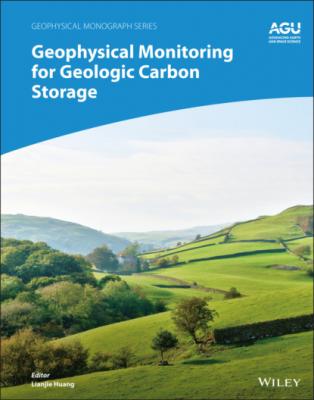ТОП просматриваемых книг сайта:
Geophysical Monitoring for Geologic Carbon Storage. Группа авторов
Читать онлайн.Название Geophysical Monitoring for Geologic Carbon Storage
Год выпуска 0
isbn 9781119156840
Автор произведения Группа авторов
Жанр География
Издательство John Wiley & Sons Limited
Figure 4.10 The true locations of microseismic events (black dots) used for optimal design of a borehole geophone array.
We quantify the event location accuracy for each geophone distribution by calculating the mean accuracy of located events relative to their true locations. The relationship between the location accuracy and the total number of geophones for different scenarios is shown in Figure 4.12. We see that the event location accuracy does not change much when the number of geophones increases beyond 50. Therefore, 50 would be an optimal number of geophones needed to achieve a good balance between event location accuracy and the cost.
Figure 4.11 The initial (blue dots) and relocated (red dots) microseismic events obtained using different numbers of borehole geophones (green triangles) for the synthetic study in Figure 4.10. The number of geophones shown as examples is 5 (a‐b), 30 (c‐d), and 100 (e‐f).
4.5. DISCUSSION
One assumption we have made in this study is that all seismic stations in the network can record the primary phase arrivals from all events. In reality, only close enough stations can detect useful signals for the seismic events below a certain magnitude. The detection capabilities of stations also depend on the focal mechanism of the events, attenuation structure, and noise level. The synthetic demonstration examples shown in this study can be viewed for only the seismic events that are large enough to be recorded by all seismic stations. Based on the detectability of the smallest seismic events needed to monitor, similar approaches as we describe in this chapter can be applied to different scales.
Different data‐processing procedures, such as single‐component versus multicomponent data processing, single‐station versus array‐signal processing, first arrivals only versus multiple phases, and different location techniques (e.g., Lin & Shearer, 2005; Pesicek et al., 2014), may generate slightly different location results for the same network distribution, but the trade‐off curve between the event location accuracy and the number of seismic stations can still be obtained using the approach described in this chapter.
Figure 4.12 Event location accuracy versus the total number of geophones for optimal design of a borehole geophone array in Figure 4.10.
4.6 CONCLUSIONS
We have developed a methodology for the optimal design of seismic networks for monitoring induced microseismic events during CO2 injection and storage. Based on the location of the target monitoring region where induced microseismic events may occur, we design a regularly spaced surface seismic array within an area centered at the target monitoring region, or regularly spaced borehole geophone array above the target monitoring region. We vary the number of seismic stations/borehole geophones, and compute the event location accuracy using both absolute and differential travel times. The optimal seismic network is determined using the trade‐off curve between the mean location accuracy and the number of seismic stations. We have demonstrated our methodology using a synthetic model for the Kimberlina CO2 storage demonstration site in California. Our results show that for the specifically defined monitoring regions in this study, it needs approximately 20 surface seismic stations or 50 geophones for cost‐effective monitoring. These demonstration examples assume that seismic events of interest can be recorded by all stations within the network. Similar approaches can be applied to different scales of microseismic monitoring problems depending on the detectability of the smallest seismic events needed to monitor. For the same total number of seismic stations, irregularly spaced seismic stations produce similar results to those obtained with regularly spaced seismic stations, as long as they have good enough azimuthal and distance coverage. Three‐component seismic stations are recommended over one‐component seismic stations to include more accurate readings of S‐wave arrival times to improve the locations of microseismic events.
ACKNOWLEDGMENTS
This research was supported by the U.S. Department of Energy (DOE) through the Los Alamos National Laboratory (LANL), which is operated by Triad National Security, LLC, for the National Nuclear Security Administration (NNSA) of U.S. DOE under Contract No. 89233218CNA000001. The work was part of the National Risk Assessment Partnership of the Carbon Storage Program managed by the National Energy Technology Laboratory. We thank William Foxall for providing us with the initial velocity model for the Kimberlina site. We thank two anonymous reviewers for their valuable comments.
REFERENCES
1 Birkholzer, J. T., Zhou, Q., Cortis, A., & Finsterle, S. (2011). A sensitivity study on regional pressure buildup from large‐scale CO2 storage projects. Energy Procedia, 4, 4371–4378.
2 Boullenger, B., Verdel, A., Paap, B., Thorbecke, J., & Draganov, D. (2015). Studying CO2 storage with ambient‐noise seismic interferometry: A combined numerical feasibility study and field‐data example for Ketzin, Germany. Geophysics, 80(1), Q1–Q13. https://doi.org/10.1190/geo2014‐0181.1
3 Chatelain, J.‐L., Roecker, S. W., Hatzfeld, D., & Molnar, P. (1980). Microearthquake seismicity and fault plane solutions in the Hindu Kush region and their tectonic implications. Journal of Geophysical Research, 85(B3), 1365–1387.
4 Coblentz, D., Lee, R., Wilson, J., & Bradley, C. (2014). Kimberlina, California site characterization for applications to potential induced seismicity. Technical Report. Los Alamos National Laboratory.
5 Eisner, L., Hulsey, B. J., Duncan, P., Jurick, D., Werner, H., & Keller, W. (2010). Comparison of surface and borehole locations of induced seismicity. Geophysical Prospecting, 58(5), 809–820. https://doi.org/10.1111/j.1365‐2478.2010.00867.x
6 Ellsworth, W. L. (2013). Injection‐induced earthquakes. Science, 341(6142). https://doi.org/10.1126/science.1225942
7 Gomberg, J. S., Shedlock, K. M., & Roecker, S. W. (1990). The effect of S‐wave arrival times on the accuracy of hypocenter estimation.

